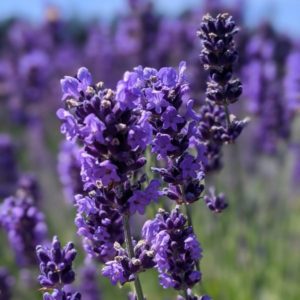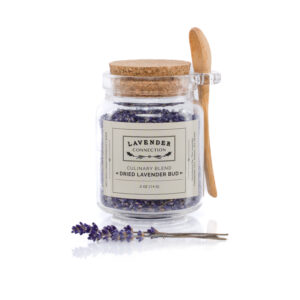Can you eat lavender?
One of the most common questions we hear from customers is, “Can you eat lavender?” or “Is lavender edible?” The answer is a resounding yes!
We’ve seen a dramatic increase over the last few years in customers buying culinary lavender, and have noticed lavender showing up in recipes, cocktail menus, and even specialty items like lavender chocolate. So we decided it was time to pique your curiosity and/or answer your most pressing questions about culinary lavender!
What does lavender taste like?
This question is difficult to answer because it’s hard to describe the taste of something so unique! Much like mint tastes…well… minty, lavender tastes lavender-y. Good culinary lavender will add a rich “under” tone to dishes – much like a spice – as well as sweet floral notes. It can take something simple and basic, like shortbread or vanilla ice cream, and turn it gourmet with just a pinch. If you like the smell of lavender, chances are you’ll love the taste.
What is culinary lavender? Is there a difference between "regular" lavender and culinary lavender?
The biggest question customers have once they understand they can eat it (aside from how to cook with lavender) is, “What makes lavender culinary? Is there a difference?” The most important thing to know is that all lavender is edible. It is helpful to remember that lavender is a perennial herb – we’re used to thinking of it as a flower, but it is actually in the same family as mint.
What does that mean for you? Any lavender you’ve got planted in your garden is theoretically edible!
What is the best type of lavender for culinary?
That being said, some kinds of lavender taste better than others. It is widely accepted that lavandula angustifolia (sometimes referred to as English or True lavender) is the best tasting lavender, because it doesn’t have a high camphor content (camphor is the bitter taste that makes some lavender taste like medicine or soap). Thus, any lavandula angustifolia variety should be good for cooking – but keep in mind taste isn’t the only consideration. While it may sound cool to purchase a pink or white lavender for cooking, these lavender buds dry grey and aren’t very visually appetizing in food. For cooking, we recommend lavandula angustifolia varieties that dry a deep, dark purple. All of the culinary lavender we sell is “Royal Velvet” for this reason. If someone is eating a lavender cookie, they want to see purple flecks in it. Just trust us on this.

The other common lavender species in the United States is lavandula x. intermedia, or “French” lavender. The herb mixture “Herbs de Provence” typically includes lavender buds or leaves, and often this mixture uses intermedia lavender rather than angustifolia – so it’s not unheard of to eat this species. If you really want to try cooking with your intermedia plant you’ve got in the yard, give it a shot – but remember lavandula intermedia does have noticeably more camphor in it than angustifolia (check out our angustifolia vs. intermedia blog), so be prepared for more bitterness, and compensate by adding less lavender than the recipe calls for.
What type of lavender isn't good for culinary?
We don’t recommend eating the ornamental lavender varieties like lavandula stoechas (or “Spanish” lavender) lavandula dentata, or the intensely camphorus lavandula lanata (or Spike lavender.) Again, they won’t hurt you, but they won’t taste good.
So can I eat the lavender in my yard?
Assuming you can recognize what species you have, and you feel confident it’s an angustifolia (or you’re prepared for the more bitter taste of an intermedia), then yes! (See above for our recommendations against eating other lavender species.) Dried bud is the best for cooking with, though fresh lavender flowers can absolutely be used for garnish or to add a pop of color to a lavender drink.
If you aren’t sure of the species you’ve got, or you don’t have lavender in your yard, don’t fret – we sell our culinary lavender in a jar, a grinder, and even in bulk. So no matter your price point (or recipe needs), we’ve got you covered.
Up Next...
Up next, we’ll answer more culinary lavender questions, like “How do I use lavender in cooking?”, and “Can I cook with lavender essential oil?” Let us know if you have a culinary lavender question, and we’ll add it to an upcoming blog post!
pssssst – Thanks for reading our blog! Want to try cooking with culinary lavender? Enter code 9UF4K5RZ at checkout for 10% off!

8 Replies to “Culinary Lavender: What is culinary lavender?”
Jose
Thanks so much for the information you provided. I have the Hidcote Blue lavender variety. I have found that the dried buds taste a bit citrusy. I use it to make a version of the Apricot, Walnut, and Lavender Sourdough Bread from theperfectloaf.com. This variety, not only tastes good, but it is beautifully dark.
Rebecca Olson[ Post Author ]
That’s great to know! We just planted the Hidcote Blue variety, so I’ll have to dry some this year and try out the bud!
Shannon
I have question: are culinary lavender buds harvested pre or post flowering? Just trying to figure out the harvesting timing.
Rebecca Olson[ Post Author ]
Hello – that’s a great question! When harvesting for bud, you want to harvest the buds before they flower. However, you don’t want to harvest too early or the buds won’t be large or fully developed. Ideally you want the buds to be plump and just about to flower. Since lavender typically flowers a little at a time (rather than all at once) we keep an eye on it this time of year and harvest when 10-20% of the plant has flowered. Hopefully that helps!
Arlene Schueller
Do you just add the buds in your baking items (batter) and crème brûlée’s or do they to be ground up ????
Rebecca Olson[ Post Author ]
Arlene – great question! We recommend grinding up your lavender buds when baking with them. Biting into a full lavender bud will most likely be too intense. You can leave the buds full if you’re using them in tea, or steeping to make simple syrup, etc.
Darpan Patel
Hello, I visited Lavender Connection Farm last year and absolutely love Lavender Earl Grey Tea and Lavender Bud I bought. Is it possible for me to use Culinary Lavender with other types of tea? For example, add a little bit of culinary lavender with loose tea leaves or use just culinary lavender by itself to make tea? Thank you!
Rebecca Olson[ Post Author ]
Hello – great question! You absolutely can use our culinary lavender bud to mix and create your own lavender tea blends. The bud we use in our Lavender Earl Grey tea is exactly the same as the bud we sell in bulk. Good pairings with lavender are plain black tea, chamomile, mint and berry. You can even do just plain lavender as a tea, though I prefer pairing it with something else. Good luck, and let us know what you come up with!